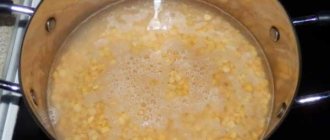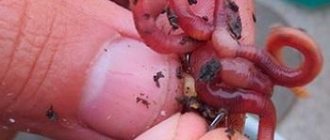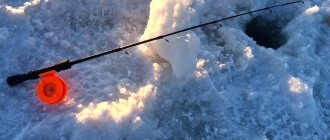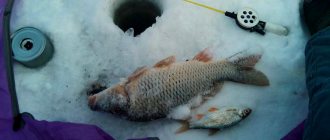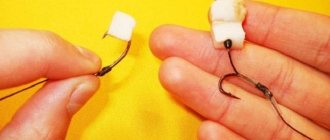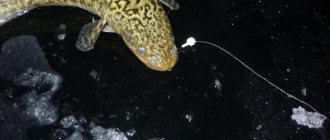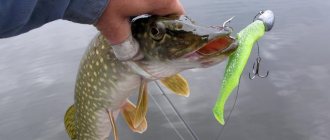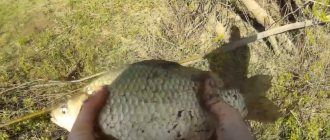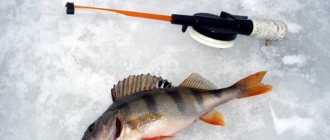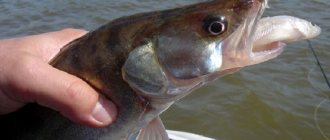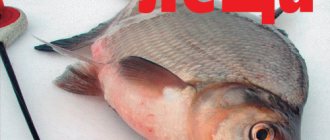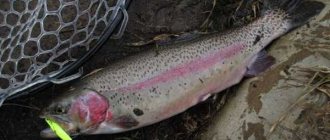Donka is considered the oldest fishing invention, which has been feeding fisherman for many years. Most inhabitants of reservoirs prefer to feast on a variety of worms on the surface of the bottom of the reservoir. It is them that we will go to catch with the help of this bottom equipment.
A donka equipped with a feeder is used not only by amateurs, but also by professional athletes. It is often used as additional equipment for ring fishing. But this is not the only advantage of donka, as you will learn about later in the article.
How to fish with a donka with a feeder?
In order for your fishing to be effective, you should know some fishing rules:
- choose the area for fishing wisely;
- Make about twenty test casts so that the feeder reaches the surface of the bottom of the reservoir. Then make a powerful hook to release the remaining bait from the structure. This is especially important in bodies of water characterized by strong currents;
- at the moment the structure touches water, the bait should not fall out of it;
- In order to organize the casting of the equipment to the same place, it is necessary to insert the monofilament into the clip near the reel for the first time. Take the tackle out of the water and fill it with food again, and then cast along a guideline. Only after this can the tackle with the hook hit the same point;
- You should not equip the tip of the rod with a bell. This can not only get on the nerves of nearby fishermen, but also scare away the fish. You will see when it bites;
- if after five minutes there are no bites, it is recommended to check the tackle and fill it with new bait;
- After final assembly of the gear, it is worth doing a small test. Pay special attention to the free sliding of the monofilament through the rings;
- When mounting the rod on the stand, it is important to avoid pressing the monofilament thread. Otherwise you won't be able to see the bites.
Options for a donkey with a feeder
If you lack excitement in life, then extreme fishing in reservoirs with strong currents will be to your liking. In this case, the most suitable equipment would be a feeder with a donk and a feeder. It can be used at great depths, in strong currents and when hunting for trophy predators.
The following models are distinguished:
- feeder trap;
- cylindrical;
- cone shape;
- and with a flat lid.
The area for fishing in the coastal zone is chosen away from vegetation. At the beginning of fishing, it is recommended to cast as often as possible to ensure the required amount of complementary food.
If desired, and naturally possible, you can add complementary foods by hand. It’s better to throw feeders in one place, or at least try. Well, what is very important is not to miss the bite. After all, your catch will depend on this.
Feeders for various fishing conditions
- If you decide to fish in backwaters where there is a light current, then in this case the so-called trap feeder is ideal for you. If it is necessary to ensure instant dispersion of the bait along the bottom of the reservoir and create a whole cloud of complementary food, then use a feeder trap. A trap with a short leash and light weight will be optimally suitable. The bait itself should be loose and not stick tightly to the structure. But a very sticky base won't work either. It is necessary to find a “golden mean” so that it is evenly distributed along the coast. You can purchase such a mixture in specialized stores, but creating it yourself is also easy.
- For stormy river fishing, feeders with a flat lid are perfect.
- In fast currents when hunting for roach, bream and chub, give your preference to a design with a large mass (about 60 g) and a lid in the shape of a flat rectangle. Only in this case can a gradual and uniform spraying of the bait be ensured.
- For river spaces characterized by low currents, cylindrical-shaped feeders are suitable. Some models are additionally equipped with special systems for bait control. This will allow you to add complementary food to the structure without even removing it from the water.
- For fishing in deep water bodies, for example, on lakes, take cone-shaped models. This is an ideal option for catching a trophy predator, which is very active in the pond and swims quickly. For such an instance to stop, something truly special must be provided.
- A special ball is placed in the middle of the structure, which is completely filled with worms and a small amount of porridge. This model must be securely fastened to a monofilament thread in order to easily hook a predator in the future.
"Eggs" and "ring"
One of the few options that are unable to work on the shore during bottom fishing. The exception to the rule is high, steep cliffs.
Both gears are similar to each other, despite their different names. “Eggs” have a double sinker (two interlocking balls), and “Ring” has a correspondingly shaped weight.
The bait is kept within 20–30 centimeters from the bottom surface. When an inhabitant of aquatic fauna attacks, the sinker is instantly unhooked from the stern cord, and the fisherman begins to fish.
ADVICE! The only drawback of these gears is the high probability of entanglement. The fisherman will have to sit in the boat, keep the potential catch in one place, and not let it swim around the anchor and stern cord. If the fish manages to accomplish its plan, the fisherman will get a lot of trouble.
There is a requirement for a fishing rod: it must be shortened and strong, so that it is more convenient for a person to operate it on water transport.
Equipment
As a fishing line, you can use monofilament thread or braid. The last option is still better, but its cost is also strikingly different.
If you need to ensure long casting or use a very heavy feeder, you should give preference to braided wire with a diameter of 0.1-0.2 mm. Whereas monofilament is selected thicker - 0.2-0.4 mm. Although monofilament thread also has its advantages. It is almost invisible in the water column and is very convenient during maintenance.
In the center of all equipment there is a donka. The variety of this kind of gear is also simply surprising. Today, monofilament or spinning rods can boast such an assortment.
But no matter how much effort feeder manufacturers put into creating new models, there will always be fishermen who will make homemade ones more effective and catchy than purchased options.
The optimal rod should be held in one place without any effort, and in the same way, in the process of moving the fishing rod, it should calmly come off the surface of the bottom of the reservoir in a matter of seconds. But experienced fishermen immediately warn that you can only find a suitable feeder option while fishing, and not the first time. This means that when going hunting for aquatic life, you need to prepare several models of donks, even those that, at first glance, are completely unsuitable for this area.
Plus, don’t forget about donkey leashes. You also need a lot of them, with different hook numbers and line diameters. This is because only by fishing you can see the real behavior of the fish at a given time of the year. This is impossible to predict.
If we are talking about specialized gear, this includes bite alarms and stands for them, then you cannot do without it. In the first case, you will never miss a bite, and in the second, you will fish calmly without any inconvenience.
Bait for bream
To choose the right bait and start fishing, you need to use several rules:
- Use bait that is also in the food. If there is a worm in the food, then a worm must be placed on the hook.
- The bait is selected based on the food in the pond. If the water area is predominantly inhabited by mormysh, then it should be used as bait on a hook.
- The temperature of the water should also be taken into account. In cold water, bream feed on animal baits, and in warm water, on plant foods.
- Fish are caught well with worms, bloodworms, maggots, peas, polystyrene foam, pasta, bread dough, hominy, and pearl barley.
- Any bait should be changed as often as possible.
- When using bread or semolina as bait, you should roll it into a ball and place it on the hook so that the tip is not visible.
- If worms are used, they must move. You need to plant them in 5 pieces in bunches so that the hook remains invisible.
When fishing you need to have several baits. Before fishing, you should attach them and check which one will be better for biting bream.
Lure
In this case, you can use worms or maggots as complementary food. But there is a certain proportion of this delicacy per kilogram of bait.
It is as follows:
- for a reservoir with a fast current - 2 handfuls;
- for a reservoir with medium flow - 3 handfuls;
- for standing water - at least 5 handfuls;
- for a pond with a slow flow - 4 handfuls.
Simple idea
A beginner's desire to go fishing leads him to a fishing store, where in front of him, like treasures from Ali Baba's cave, sellers bring out various intricate devices, bright artificial baits, fishing rods of all types and sizes. All this splendor is far from cheap and does not guarantee you a caught fish. How to be?
Blogs on the Internet are full of demonstration videos with the secrets of donk fishing. Experienced fishermen teach wisdom and tell the basics of this interesting type of active recreation. The principle is simple. A weight and a hook(s) are attached to the main line.
When thrown into the water, the weight sinks to the bottom, and hooks with bait are located nearby and wait for the hungry future trophy to become interested in your “tasty” offer.
What kind of fish are caught on a donk with a feeder?
Using a donk with a feeder you can catch not only peaceful fish, but also, for example, predatory carp. But for this it is worth using different models of gear and adhering to the special specifics of the game. Although both options will be very interesting.
Catching carp on a donk with a feeder
Carp is a very strong and powerful fish, so when choosing gear for catching it, you should give preference to reliable samples. It is better to place the nozzle near the bait so that he constantly watches it.
It is recommended to cast often enough as the fish may leave the area. And don't forget about accuracy. After all, scattering along the surface of the bottom of the reservoir, the fish can go quite far and you are unlikely to be able to catch it.
Catching crucian carp on a donk with a feeder
Collecting crucians in the same place is not as easy as it might seem at first glance. To do this you will need a lot of feed and effort. Experienced fishermen advise starting in the evening, and by nightfall you will be able to catch a truly trophy specimen.
Catching carp on a donk with a feeder
Carp has always been shy and cautious, even taking into account the fact that it is a predator. His movements can be both for and against the current. But the beauty is that he is used to robbing at great depths. It could be twenty meters. Therefore, when looking for a predator in the pits, you can never go wrong. Basically, it is good to catch carp on a donk, but each fisherman has his own subtleties in catching a trophy catch.
There are no other inhabitants there. It is generally accepted that carp are very unpredictable and its bites are no exception. Therefore, if you want to catch a predator, you should immediately tune in to several fishing trips. Initially, it is advised to track and study the area, the behavior of the fish, and only then can we talk about the effectiveness of fishing.
After such torment, you will be able to find the habitat of the flock. Then beware, your catch will be huge. The main thing is to take him home.
Remember, carp is characterized by immigration within 24 hours. He is constantly on the move.
Catching bream on a donk with a feeder
It is worth looking for bream in especially large and medium-sized river reservoirs. Therefore, you should not neglect the presence of a current, which will scatter your bait over long distances. The benefit is that the fish will follow the bait and move in its direction.
And therefore you will have a chance to catch a truly trophy specimen. Using a feeder is also beneficial because you can search for fish even in windy times on big waves. Bream never comes close to the coast. Therefore, casting should be done as far as possible.
Vegetable bottom baits
An original, always available and very diverse alternative to animal ingredients. Vegetable baits naturally continue the taste of bait, so they do not alarm even the most cowardly fish. Thanks to the possibility of light aromatization, they effectively attract the inhabitants of the aquatic area even from long distances.
Another advantage of vegetable donkey baits is their color. The same fresh peas can be rich green, canned corn can be bright yellow, pearl barley can be painted crimson, and so on. All of them can visually attract fish from afar, especially in clear water.
The most popular plant baits are:
- Pearl barley
- Corn
- Peas
- Porridge – millet, hominy and so on
- Dough
- Bread crumb
- Cake
In general, anything that has an original and interesting smell and/or taste for fish, and also holds well on the hook, is suitable. There are hundreds of recipes.
Tips and secrets from experienced fishermen
- For experienced fishermen, I advise you to use a coast free of trees, bushes and tall grass thickets when fishing with such equipment. This is done so that in the future you can mount the stand well and comfortably distribute your gear on the shore. A lot of space is also needed to ensure maneuvers during the fishing process. Because it’s worth using not one, but at least two fishing rods;
- When you arrive for fishing, make your first casts frequently to saturate the pond with bait. Even if it doesn’t bite, do your job anyway. After all, you need to determine as accurately as possible over what period of time the composition of complementary foods dissipates in the water column. This could be one or even five minutes. But you should still cast at the same rhythm;
- if the fishing distance allows, and the current too, you can cast directly from your hands;
- For fishing to become truly effective, it is recommended to cast to one place. In order not to get lost in space, choose some landmark for yourself. This could be a tree on the opposite bank or a bush. And to shorten the casting distance, make small marks on the monofilament thread between the reel and the first ring;
- It is very important to understand exactly when to cut. Naturally, you can see by the tip of the rod when the fish is biting. But each species has its own characteristics of swallowing bait, and you should study these maneuvers. For beginners, it is recommended to skip the first nods of the fishing rod, and only then hook. After catching the first trophy, you should not change anything and act in the same rhythm. This means you are on the right path.
Of all fishing tackles, the donka with a feeder was, is and will be very popular. That is why you should not miss the pleasure of using its capabilities. Happy fishing!
Practical advice on fishing techniques
The fishing technique depends on several factors, which include: current speed, types of fish, features of the reservoir itself. From here the equipment can change, for example, with a large current, the most important principle will be to increase the sinker. Weather conditions can also make their own adjustments: in strong winds, there is no point in equipping a fishing rod with a quivertip, since in this case you can easily miss the long-awaited bite; you should only rely on the feeder float.
Angling representatives of the carp family requires the need to quickly determine the direction in which the fish will pull immediately after the bite. Because in order to guarantee the catch of a large carp or crucian carp, you need to make a sharp, confident hook in the opposite direction.
fishelovka.com
Donka for pike perch
There are many options for bottom rigs for catching predators; we’ll tell you about one of the simplest. The installation resembles a feeder “inline”:
- sliding sinker or feeder;
- a hook on a leash attached to the end of the main fishing line;
- one or two hooks on leashes above the load.
Why do you need a feeder to catch a predator? You can do without it, using a regular sinker (see video below), but with bait, the chances of catching a pike perch become much greater.
A simple donka for catching pike perch and burbot:
Bait for zander
Of course, bream bait is not suitable for pike perch. It must consist of animal components:
- fresh fish minced through a meat grinder;
- beef liver or other offal.
It is not necessary to use selected products; leftovers after processing can be used. The main thing is the smell of pike perch bait, which will spread downstream.
In order for the resulting substance to acquire the required density, it is mixed with ground breadcrumbs and oatmeal (oatmeal), which will act as binders in the bait.
Pike-perch bait is put into the feeder in the same way as regular bait. The smell of fish carried by the current will definitely attract a predator. This can be not only pike perch, but also pike, burbot, catfish, a school of large perch, etc.
Tackle for catching pike perch and bream
This method is suitable for those who like to catch peaceful fish, since fans of spinning rods are unlikely to put down their gear to catch bream.
To catch pike perch, you can use a regular donka.
As mentioned above, pike perch do not always stick together with bream, therefore, it is best to use two different tackles, one of which is set up for catching pike perch and the other for bream.
To catch bream, you can use any feeder rig, a familiar bait and bream bait.
